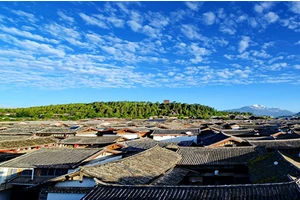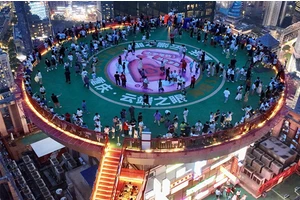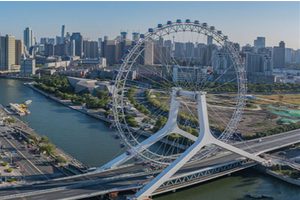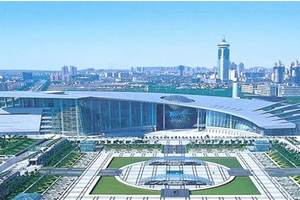Yili travel
Question 1: What are the classification schemes of tourism products?
1 sightseeing products 1.1 natural sightseeing products 1.1.1 surface sightseeing products (famous mountains, caves, canyons, deserts, islands, etc.) 1.1.2 water sightseeing products (rivers, lakes, hot springs, fountains, waterfalls, seashores, etc.) 1.1.3 biological sightseeing products (forests, grasslands, wild animals, etc.) 1.2 humanistic sightseeing products 1. Other ancient buildings, etc.) 1.2.2 Modern sightseeing products (revolutionary memorial sites, urban scenery, various venues, social activity places, tourism industry (enterprises and enterprise products), large-scale projects, etc.) 1.2.3 Artificial landscape products (miniature landscapes, antique villages, main parks, foreign cities (villages), wildlife parks, aquariums, etc.) 1.2.4 Sightseeing agricultural parks.
2 holiday tourism products 2.1 seaside holiday tourism products (resorts) 2.2 rural holiday tourism products (resorts) 2.3 forest holiday tourism products (resorts) 2.4 camping holiday tourism products (resorts) 2.5 urban holiday products (resorts, centers) 2.6 hot spring holiday products (resorts, centers) 2.7 lakeside holiday products (resorts, centers)
3 recreation and leisure products 3.1 sports tourism products 3.1.1 skiing tourism products 3.1.2 golf tourism 3.1.3 water sports 3.1.4 ball sports (table tennis, tennis, Billiards, etc.) 3.2 Health tourism products 3.2.1 Medical tourism products 3.2.2 Recuperation tourism products 3.2.3 Strength sports projects 3.3 Eco-tourism products 3.3.1 Rural tourism 3.3.2 Green tourism 3.3.3 Wild tourism 3.3.4 Flower viewing tourism 3.3.5 Forest tourism 3.4 Entertainment and leisure tourism products 3.3. Such as: amusement park 3.4.2 passive leisure products, such as sauna, *** 3.4.3 song and dance products, such as MTV, KTV and other 3.4.4 game products, such as electronic games and chess games.
4 Business tourism products 4.1 Conference tourism products (carriers such as large conference centers) 4.2 Incentive tourism products 4.3 Large business activities 4.3.1 Large international fairs or fairs 4.3.2 Large international sports activities 4.3.3 Large commemorative or celebration activities 4.3.4 Large art festivals
5 cultural tourism products 5.1 study tourism products (museum tourism, etc.) 5.2 folk tourism products (folk villages, folk families, folk festivals, etc.) 5.3 art appreciation tourism (comedies, movies, music, paintings, sculptures, handicrafts, etc.) 5.4 religious tourism products 5.5 nostalgic tourism products 5.5.1 nostalgic tourism products 5.5.2 antique tourism products 5.5.5.
6 Special Tourism Products 6.1 Mountaineering 6.2 Diving 6.3 Archaeology 6.4 Sports 6.5 Exploration 6.6 Scientific Research
7 Characteristic tourism products 7.1 Enjoy tourism products (luxury trains, luxury cruise ships, food, presidential suites) 7.2 * * type tourism products 7.2.1 Adventure tourism products 7.2.2 Adventure tourism products 7.2.3 Secret tourism products 7.2.4 underwater tourism products 7.2.5 Desert tourism products 7.2.6 Fighting beast tourism 7.2.2.
Question 2: What kinds of tours are there? The word tourism is a very broad word. As long as it is a way to attract tourists, it can be followed by these two words.
By age: youth, adventure travel (such as forest, skiing, rafting, etc.).
Middle-aged, theme tour (historical sites tour, landscape tour, etc.)
Old age, sunset red (such as a special train tour)
Others include industrial tourism (Qingdao Haier Group, Inner Mongolia Mengniu Group, Anshan Iron and Steel Group, etc.)
Overseas and domestic theme wedding groups, theme tours of red tourism (such as Jinggangshan, Yan' an, etc.), or theme tours.
There are many ways to travel, including plane, train and cruise.
The forms of travel are group tour and self-help tour (single room and car, etc.).
In short, you can use your imagination to give a good name to a tourist destination.
Question 3: What are the types of ancient tourism in China? Simply put, it is: traveling with horses and chariots.
The historical period of China's feudal society is extremely long, reaching more than 2,000 years. The reason why the feudal social system can exist in China for a long time reflects a situation from a certain aspect, that is, during the rule of China's feudal social system, especially during the rule of various unified dynasties, China's feudal society was relatively stable politically, economically and even technologically far ahead of the world. The existence of all these conditions, on the one hand, ensured the dominance of the feudal system and maintained the rule of the feudal dynasty; On the other hand, obviously, it has also brought great impetus to the development of travel. Among them, the water conservancy engineering technology represented by Dujiangyan and Lingqu and the progress of agricultural production brought about by it; Later, the development of handicrafts, mining, textiles, papermaking and ceramics made China ahead of the western world in science and technology and social economy. According to the research, among the world's scientific and technological inventions, there are more than 100 world firsts from China during this period, which made the social and economic development level of China before modern times far ahead of the world!
An important factor in traveling is traffic. It can be said that travel and transportation are inseparable. In the feudal society of China, land and water transportation had a long history in China, and water transportation was recorded as early as the Spring and Autumn Period. "Zheng Guoqu" and "Lingqu" in the Warring States and the Qin Dynasty are glorious chapters in the history of water conservancy. Moreover, since the Han Dynasty, all the feudal dynasties in China have regarded grain transportation as one of the most important policies of the country. Therefore, during the feudal society in China, water conservancy transportation was very developed and became one of the most important modes of transportation in China. Among them, the dynasty that contributed the most to land and water transportation was the Sui Dynasty. From the period of Emperor Wendi of Sui Dynasty, the land and water from Huaishui to the Yangtze River were opened. In the period of Emperor Yangdi, Tongji Canal (connecting Bian River and Si River by the Yellow River directly to Huaishui), Yongji Canal (reaching Zhuojun County in the north of the Yellow River) and Jiangnan River (connecting the Yangtze River and Qiantang River directly through Zhenjiang and Suzhou) were successively dug, which finally formed a dense and developed system of canals in North China and Jiangnan. At the same time, the navigation capacity of natural rivers was also very good at that time. Emperor Yangdi visited Yangzhou three times, and numerous large dragon boats and official numbers were convenient to pass, which shows its water transport capacity. In the Yuan, Ming and Qing dynasties, because three dynasties all built Beijing, in order to better manage the country and meet the needs of transportation, the country began the development of shipping. The starting point of the famous "Maritime Silk Road" is Quanzhou, which I visited. According to legend, Kyle Polo started his trip to China from Quanzhou, but was only a large and small cargo ship that sank in Quanzhou waters due to an accident.There are countless goods sleeping in the sea, forming a "underwater world of ceramics". It can be seen that the degree of development of shipping at that time. We say that although the development of land and water transportation was needed by the political rule and economic development of the country during the feudal society, it greatly facilitated people's travel objectively, and it became a good choice for people to travel by land and water, thus promoting the development of travel.
At the same time of the great development of land and water transportation, the land transportation in feudal society in China also made great progress. Since the Qin dynasty, the construction of land has achieved certain results. The construction of "Chi Dao", "Straight Dao", "Wuchi Road" and "New Dao" together constitute a road network with Xianyang as the center and extending in all directions. After the Qin dynasty, the construction of land transportation was not only manifested in the construction of the road itself, but also through the construction of its auxiliary facilities. The post station is one of the important representatives. The post station is a building institution built along land and water in successive dynasties. Its original purpose was to transmit official documents and national materials, and later it began to entertain national public servants, even retired people. The post station can provide dormitories, chariots and horses, boats and chairs, manpower, rice and feed, and so on. Its function is very similar to the present hotel. The development history of China's post stations is very long. As early as in Zhou Li and pre-Qin classics, Taoism can be seen. At that time, there were records of biography, placement, postal service and post office, but the setting of post offices was not very common at that time. After the continuous development of various feudal dynasties, the development of the post station reached a certain scale in the Tang Dynasty. According to records, at that time, there was a post station every 30 miles, and it was recorded in the "Records of Hundred Officials in the New Tang Dynasty" that there were 1639 post stations in the Tang Dynasty. According to this figure, the road to set up a post station should be more than 25,000 kilometers. It can be seen that the development of land transportation at that time. In the Ming and Qing dynasties, the post station was extended to inner Mongolia, outer Mongolia, Xinjiang and other regions.
With the development of transportation, China appeared very early ... > >
Question 4: What are the types of tourists? What are their respective characteristics? Classification of tourist types and their characteristics by travel purpose
No matter which standard is used to classify the types of tourists, we can find that the characteristics of different types of tourists are both common, but there are also great differences. The following is only a brief description of the characteristics of various types of tourists divided by tourism purposes.
3.1 Sightseeing tourists
Sightseeing tourists are the oldest, most common and basic types of tourists in the world, and also the main types of tourists in China, with the main purpose of visiting places of interest, customs and customs in foreign countries, and at the same time, they can be combined with shopping, entertainment, investigation and official business. Its characteristics are as follows: I hope to increase my knowledge, broaden my horizons, cultivate my sentiment and get new, strange, different, beautiful and special feelings by watching and visiting the natural and human landscapes in foreign countries; Short stay in tourist destinations, low revisit rate, low cost, and sensitive to the characteristics and prices of tourist attractions.
3.2 Recreational tourists
The main purpose of recreational tourists is to relax and enjoy the pleasure brought by the temporary change of environment. Because recreational tourism can adjust people's life rhythm and get rid of the troubles caused by daily intense work, this type of tourists is increasing day by day. Among all tourists in developed countries, recreational tourists account for the largest proportion. Its characteristics are: pursuing entertainment, participation, recreation, * * * and enjoyment; Sensitive to the quality, safety and price of tourism products; Going out has a strong seasonality, and almost all of them choose the best season of tourist destinations and use paid holidays to travel; Great freedom in the choice of tourist destinations and modes of travel; The revisit rate is high, and the travel and stay time are long.
3.3 Business tourists
Business tourists are tourists who take trade cooperation, business negotiation, attending meetings, holding exhibitions and scientific and cultural exchanges as their main purposes according to their work needs, and carry out sightseeing and other activities on the premise of completing their official duties. Its characteristics are: it has a certain status and requires higher quality of tourism products and services; The expenses are mainly paid by the group at public expense, with strong ability to pay, little sensitivity to price and high consumption; Because of official business, there is not much choice for tourist destinations and travel time. Generally, the nearest short distance and short time are the most. The number of people is relatively small, but the number of trips is more and the seasonality is not strong.
3.4 Personal and Family Affairs Tourists
The needs of such tourists are more complicated. They are different from recreational and official types in terms of needs, but they have some characteristics of both. For example, in terms of travel time, although many of them use paid holidays to visit relatives and friends, quite a few people choose traditional holidays to go out to visit relatives, and traditional holidays in different countries are not uniform. In addition, many family and personal affairs, such as attending the wedding and attending the opening ceremony, have tight dates. Therefore, its overall characteristics are: poor seasonality of travel; Sensitive to tourism prices; There is no freedom to choose a tourist destination.
3.5 Health care tourists
Medical and health tourism mainly includes convalescent tourism, leisure and holiday tourism, hot spring tourism, forest tourism, sports health tourism, qigong specialized tourism and other forms. The main purpose of medical care tourists is to treat some chronic diseases and eliminate daily work fatigue by participating in tourism activities that are beneficial to physical and mental health. Its characteristics are: higher income and more leisure time; Strong desire to stay healthy or restore health; Sensitive to the functions of health care, recreation and medical treatment in tourism projects; Middle-aged and elderly people have a large proportion and stay for a long time; There are many close tourists.
3.6 Cultural knowledge-based tourists
Cultural knowledge-based tourism is a kind of tourism form aimed at observing society, experiencing national folk customs, enriching historical and cultural accumulation and increasing knowledge. The main purpose of cultural knowledge-based tourists is to achieve positive rest and entertainment through cultural knowledge tourism, and at the same time gain enlightenment and enrichment of knowledge. Its characteristics are: high cultural literacy and strong thirst for knowledge; Have a certain specialty or special interest, and be willing to learn and communicate with others; There are high requirements for the cultural knowledge base of tour guides, and they are sensitive to the thoroughness of travel schedules and the scientific nature of travel routes.
3.7 Ecological/Adventure Tourists
Eco-adventure tourism is a new advanced tourism form emerging in the international and domestic tourism market. It emphasizes the combination of sightseeing, nature protection and cultural preservation, and is a new tourism project with environmental responsibility and environmental ethics. The main purpose of eco/adventure tourists is to get in touch with nature, understand nature, publicize and protect nature and have a positive rest through tourism ... > >
Question 5: What websites are there about tourism? What types are there? 1. Travel guide: beehive, poor travel. 2, outdoor sports: 8246, mill, green field. 3. Accommodation reservations: Ctrip, Yilong, Qunar, Meituan and taobao travel. 4. Online booking of scenic spot tickets: Tongcheng and Mama. 5. Travel "machine+wine" package: 51YOU. 6. There is also a corresponding Douban group.
Question 6: What are the classifications of tourist natural landscapes? Natural tourism landscape resources are divided into:
Geological landscape:
Such as Danxia Mountain in Guangdong and karst terrain in southwest China.
Landscape combination:
Like Lijiang scenery in Yunnan, Huangguoshu Waterfall, Three Gorges and so on.
Comprehensive natural landscape:
National geological park
Combination of climate and other natural landscapes:
Polar aurora, Sahara desert, Mediterranean coastal scenery
Question 7: What are the types of tourism enterprises according to the industrial chain engaged in tourism product management?
(1) Direct tourism enterprises include travel agencies, restaurants, restaurants, tourist shops, transportation companies, tourist attractions, entertainment places, etc.
(2) Auxiliary tourism enterprises include management companies, service companies, film and television companies, publishing units, communication facilities, food, health and other life service departments and industries.
(3) Development organizations include relevant institutions, tourism colleges, tourism research institutions, etc.
According to the main business resources used in tourism activities
(1) Labor-intensive tourism enterprises
(2) Capital-intensive tourism enterprises
Question 8: What types of tourist attractions can be divided into? It should be said that they are tourism resources, which can be divided into natural tourism resources and humanistic tourism resources. Natural tourism resources include: 1. Geological landscape tourism resources; 2. Water landscape tourism resources; 3. Meteorological climate tourism resources; 4. Biological tourism resources; Humanistic tourism resources include: 1. Cultural relics; 2. Classical gardens; 4. Literature and art; 5. Religious culture; 6. Modern facilities; 7. Folk customs; 8. Catering and shopping.
Question 9: What are the types of tourism products? Group package tour, individual package tour, semi-package tour, small package tour, zero package tour, package tour, single service.
The top ten leading tourist stocks in China are: 1. China Zhongmian; 2. Lingnan Holdings; 3. Jinjiang Hotel; 4. Qujiang Wenlv; 5. Zhongxin Tourism; 6. Zhangjiajie; 7. Lijiang tourism; 8. cits joint; 9. CYTS; 10. Travel in Xi 'an.
1. China Tourism Group Zhongmian Co., Ltd. (formerly China International Travel Service Co., Ltd.) is a listed company controlled by China Tourism Group Co., Ltd., which is a large-scale joint-stock enterprise focusing on tourism retail business. In 2009, China Tourism Group Zhongmian Co., Ltd. (stock code: 601888, formerly China International Travel Service Co., Ltd.) was officially listed on the Shanghai Stock Exchange, and officially landed in the A-share market, opening a new page in the company's development history. The business of China Tourism Group China Exemption Co., Ltd. covers tax exemption, tax, tourism retail complex and so on. In the future, the company will continue to maintain the sustained, stable and healthy growth of duty-free business, adhere to the concept of "customer-centered, market-oriented", upgrade the value chain with "duty-free business" as the core and upgrade the industrial chain with "tourism retail" as the extension, further build a world-class global tourism retail operator and make new contributions to building China Tourism Group into a world-class tourism service group with global competitiveness.
2. Lingnan Holdings. Guangzhou Lingnan Group Holding Co., Ltd. (SZ000524) is a listed company on the main board of Shenzhen Stock Exchange, and it is a platform for the operation and integration of Lingnan Group's tourism industry, the innovation and development of brand business, and the investment and financing management capital platform. With innovative development and capital operation, the company builds global tourism destination resources, conference and exhibition resources, tourism transportation resources and partner resources, and integrates online and offline to share a pan-tourism ecosystem, and develops into a modern business travel brand comprehensive service operator with high trust and good satisfaction, which is at the forefront of the country, internationally renowned, industry-leading and internationally competitive.
3. Qujiang Wenlv. Xi' an Qujiang Cultural Tourism Co., Ltd. originated from the Furong Lake under the Big Wild Goose Pagoda, and it has its own charm of prosperous Tang Dynasty and charm of Chang 'an. Gather wisdom in Qujiang Wentou Qujiang New District, and carry the image of the city and the whole industry. In 2012, the first "light asset model" in China was listed with stock code 600706. Up to now, an integrated operation and development platform for the whole industry chain of cultural tourism has been constructed, covering four major sectors: cultural tourism industry research and product research and development, scenic spot operation management, hotel catering management and tourism brand marketing, which can export three major businesses: cultural tourism consultation, scenic spot and hotel hosting operation.
Top ten leading stocks of food and beverage
The top ten leading Internet stocks in China in 2022 are:
360601360, Sanqi Entertainment 002555, ST Zhongying 002464, Shanghai Ganglian 300226, Youke 688158, Baoxin Software (600845), Inspur Information (000977), 2345 (002195), Yingshisheng (300377), etc.
On March 25th, it was reported that the opening price of 360 was 10 yuan, and it closed at 994 yuan. Within three days, the stock price fell by 181%, with a total market value of 7102.5 billion yuan.
The leading stocks in the Internet concept are not immutable, but we judge which stocks may become leading stocks according to the profitability of the stocks and the actual trend of the market. Once they become leading stocks, their trend will be unstoppable.
Top ten leading stocks of GEM technology
According to the statistics of Southern Fortune Network in December 2021, the leading stocks of food and beverage are Wuliangye, Kweichow Moutai, Yili and Haitian Weiye.
Wuliangye: the leading stock of food and beverage. In the third quarter of 2021, the company's total revenue was 129.7 billion, a year-on-year increase of 1061%; The net profit was 412.7 billion, up 1184% year-on-year.
Kweichow Moutai: the leading stock of food and beverage. The quarterly report of the third quarter of 2021 shows that Kweichow Moutai achieved a total operating income of 263.3 billion yuan, a year-on-year increase of 999%; The net profit was 126.1 billion yuan, a year-on-year increase of 1235%.
Yili shares: food and beverage leading shares. Yili's quarterly report in the third quarter of 2021 shows that the company achieved revenue of 28.5 billion, an increase of 861% year-on-year; The net profit was 262.2 billion, a year-on-year increase of 1456%; Earnings per share is 04300 yuan.
Haitian Weiye: the leading stock of food and beverage. Haitian Weiye's quarterly report in the third quarter of 2021 shows that the company achieved revenue of 566.2 billion, a year-on-year increase of 311%; The net profit was 135.5 billion, a year-on-year increase of 275%; Earnings per share is 03200 yuan.
Wuliangye: A stock issued by Sichuan Yibin Wuliangye Group Co., Ltd. Its main business scope is the manufacture and sales of alcoholic drinks and Wuliangye, and it has won the national quality management award. The company has been successfully listed on the Shenzhen Stock Exchange with the stock code of 000858.
Kweichow Moutai: A stock issued by Kweichow Moutai Co., Ltd., its stock code is 600519. The company's main business is to produce and sell Moutai, which is very famous all over the world, as well as other drinks and beverages.
Yili: A stock issued by Inner Mongolia Yili Industrial Group Co., Ltd., its stock code is 600887. Yili is a well-known dairy brand in China, and its milk and drinks are loved by consumers and famous internationally.
Foshan Haitian Seasoned Food Co., Ltd. In 1955, 25 ancient sauce gardens with outstanding strength, delicious taste and reputation in Hong Kong and Macao in Foshan were strategically merged and reorganized. Its stock code is 603288.
In addition, the following food and beverage stocks also performed well.
Tianrun Dairy: A stock issued by Xinjiang Tianrun Dairy Biological Products Co., Ltd. with the stock code of 600419. The company's main business is to produce and sell all kinds of dairy products, and it is the only listed dairy company in northwest China.
Angel Yeast: A stock issued by Angel Yeast Co., Ltd. under the stock code. The company's main business is to produce and sell all kinds of yeast and yeast derivatives. It was successfully listed on the Shanghai Stock Exchange in 2000 with the stock code of 600298.
Sanquan Food: A stock issued by Sanquan Food Co., Ltd., its stock code is 002216. The company's main business is the production and sales of various quick-frozen foods. The quick-frozen products include jiaozi, glutinous rice balls and zongzi, which are commonly found in freezers of major supermarkets.
Chengde Lulu: A stock issued by Hebei Chengde Lulu Co., Ltd., whose main business scope is the production and sales of various canned foods. It is a large-scale canned food listed company in China and successfully listed on the Shenzhen Stock Exchange in 1997 with the stock code of 000848.
Daodaoquan: A stock issued by Hunan Baling Oil&Fat Co., Ltd. with the stock code of 002852. Its main business scope is to produce and sell all kinds of edible oils and condiments. It is the largest oil processing factory in Hunan, and its products are well known.
Juewei Food: a stock issued by Juewei Food Co., Ltd. with the stock code of 603517. Its company sells all kinds of cooked food, mainly braised duck. The delicious duck neck is famous all over the country, and there are its chain stores and business outlets in various places.
Jiajia Food: A stock issued by Jiajia Food Group Co., Ltd., which is mainly engaged in the manufacture and marketing of various sauces and condiments.
Military leading stocks rank in the top ten.
The top ten leading stocks of GEM technology are: Zhongke Haixun (300810), Robotech (300757), Hanwei Technology (300007), Jifeng Technology (300022), Netac Technology (300042), Moment Technology (300802) and Silicon Treasure Technology (300010).
The leading stock index refers to the stocks that have influence and appeal to other stocks in the same industry sector in the speculation of the stock market in a certain period, and its ups and downs often play a guiding and exemplary role in the ups and downs of other stocks in the same industry sector.
The leading stock is not static, and its position can only be maintained for a period of time. The basis for becoming a leading stock is that any information related to a stock will be immediately reflected in the stock price.
Leading conditions:
1 leading stocks must start from the daily limit, which is the most accurate attack signal for both long and short sides. The stocks that can't be daily limit can't be the leader.
2 leading stocks must have a monopoly position in a certain fundamental aspect.
The circulation market of leading stocks should be moderate, and it is impossible for large-cap stocks and small-cap stocks to act as leaders. In November, the market value of start-up stocks was mostly around 500 million.
4 leading stocks must meet the requirements of daily KDJ, weekly KDJ and monthly KDJ at the same time.
The leading stocks are usually at the end of the market decline. When the market panics, they go against the daily limit, bottom out in advance, or start before the market, and stand the test of a round of decline in the market. Another example is Taiyuan corundum, a new leading company, which appeared on December 2nd. It conforms to the leading tactics just mentioned. First, it starts from the daily limit, and the chips are stable. Second, the low price is 391 yuan. Third, the market value of circulation is only 4.5 billion, and it was only 6.4 billion on Tuesday. From the bottom, it is only 1 billion, which means that less than 200-300 million private equity funds or hot money can be speculated. Fourth, Zhou Yue KDJ made a gold fork at the same time, indicating that the main force of the stock is well prepared. Fifth, at the end of the market panic, the stock went against the daily limit. At this time, the market was still falling, but it did not affect the daily limit of the stock. Through the above introduction, we can see the rise and fall process of the faucet, which also shows that the decline is not terrible. What is terrible is that the market has fallen and there is no faucet.
The top ten leading military stocks are:
The code of AVIC Xifei A shares is 000768, and the issuer of the shares is AVIC Xi 'an Aircraft Industry Group Co., Ltd., which was listed on the A shares on June 26, 1997. The current total market value is 892.6 billion yuan.
The code of AVIC A shares is 002013, and the issuer of the shares is AVIC Electromechanical System Co., Ltd.. The company was listed on the A-share market on July 5, 2004. The current total market value is 613.4 billion yuan.
The A-share code of AVIC Optoelectronics is 002179, and the issuer of the stock is AVIC Optoelectronics Technology Co., Ltd., which was listed on the A-share market on November 1, 2007. The current total market value is 102.2 billion yuan.
The A-share code of AVIC is 02357, and the issuer of the shares is China Aviation Science and Technology Industry Co., Ltd., which was listed on the A-share market on October 30, 2003. The current total market value is 3,917.4 billion yuan.
The code of AVIC Shen Fei A shares is 600760, and the issuer of the shares is AVIC Shen Fei Co., Ltd., which was listed on the A shares on June 4, 1996. The current total market value is 148.2 billion yuan.
The A-share code of Hangfa Power is 600893, and the issuer of the shares is China Hangfa Power Co., Ltd., which was listed on the A-share market on April 8, 1996. The current total market value is 156.4 billion yuan.
The code of Hangfa Control A shares is 000783, and the issuer of the shares is China Hangfa Power Control Co., Ltd., which was listed on A shares on June 20, 1997. The current total market value is 36.4 billion yuan.
The code of Torch Electronic A shares is 603678, and the issuer of the shares is Fujian Torch Electronic Technology Co., Ltd., which was listed on the A shares on December 20, 2007. The current total market value is 341.7 billion yuan.
The code of A shares of Guangwei Composite Materials is 300699, and the issuer of the shares is Weihai Guangwei Composite Materials Co., Ltd., which was listed on A shares on February 5, 1992. The current total market value is 385.8 billion yuan.
The code of Aerospace Rainbow A shares is 002389, and the issuer of the shares is Aerospace Rainbow UAV Co., Ltd., which was listed on A shares on November 30, 2001. The current total market value is 211.6 billion yuan.






